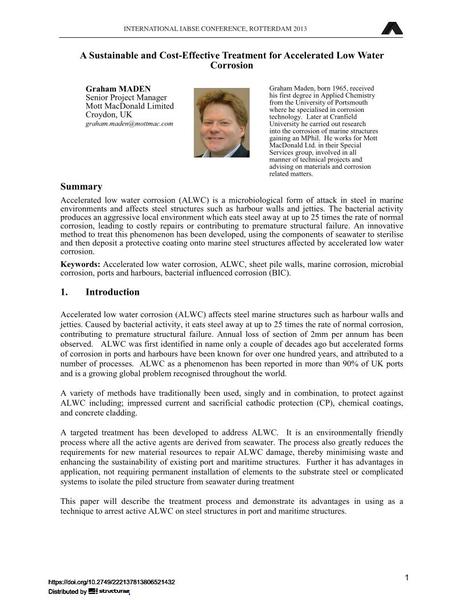A Sustainable and Cost-Effective Treatment for Accelerated Low Water Corrosion

|
|
|||||||||||
Bibliographic Details
| Author(s): |
Graham Maden
|
||||
|---|---|---|---|---|---|
| Medium: | conference paper | ||||
| Language(s): | English | ||||
| Conference: | IABSE Conference: Assessment, Upgrading and Refurbishment of Infrastructures, Rotterdam, The Netherlands, 6-8 May 2013 | ||||
| Published in: | IABSE Conference, Rotterdam, May 2013 | ||||
|
|||||
| Page(s): | 552-553 | ||||
| Total no. of pages: | 5 | ||||
| Year: | 2013 | ||||
| DOI: | 10.2749/222137813806521432 | ||||
| Abstract: |
Graham Maden, born 1965, received his first degree in Applied Chemistry from the University of Portsmouth where he specialised in corrosion technology. Later at Cranfield University he carried out research into the corrosion of marine structures gaining an MPhil. He works for Mott MacDonald Ltd. in their Special Services group, involved in all manner of technical projects and advising on materials and corrosion related matters. Accelerated low water corrosion (ALWC) is a microbiological form of attack in steel in marine environments and affects steel structures such as harbour walls and jetties. The bacterial activity produces an aggressive local environment which eats steel away at up to 25 times the rate of normal corrosion, leading to costly repairs or contributing to premature structural failure. An innovative method to treat this phenomenon has been developed, using the components of seawater to sterilise and then deposit a protective coating onto marine steel structures affected by accelerated low water corrosion. |
||||
| Keywords: |
sheet piling accelerated low water corrosion ALWC marine corrosion microbial corrosion ports and harbours bacterial influenced corrosion (BIC)
|
||||
